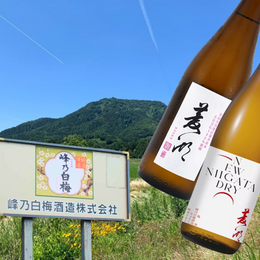
Terada Honke is one of the most prominent sake makers that have opened a door to a whole new way of appreciating the sake category for drinkers around the world. This 350-year-old brewery is regarded as one of, if not the finest, maker of “natural sake” by connoisseurs, including the legendary Copenhagen restaurant, Noma.

The late Terada Keisuke is credited for reinventing the brewery in the 1980s.
The long legacy isn't its claim to fame. Instead, it was the brewery's turning-point in the 1980s when Terada Keisuke, the 23rd-generation owner, fell seriously ill with gastroenteritis one day. Laying in bed, Keisuke’s rumination led him to a guilty thought that he had been doing a lot of “rotten” things in his sake business. He felt that he did not genuinely put his heart into the sake business; placing money before quality, using the cheapest rice and cheapest methods of sake-make just like every other average brewery was doing.

By cutting corners and adding distilled alcohol, they were making an inferior and less healthful product. Keisuke's gastric illness, he believed, was somehow a karmic payback for cutting corners in the sake business.
So he returned from his sickbed to radically reinvent his brewery with processes that were closer to nature. Lab cultured yeast was replaced with more effort-intensive wild fermentation processes such as the kimoto or bodaimoto methods. Organic rice was used, and very minimal rice polishing was done so that the grains retained most of their rustic, natural flavour. They also ended the practice of adding distilled alcohol, focusing entirely on Junmai-grade sakes.

Terada Honke is presently stewarded by its 24th-generation custodian, Terada Masaru– a 40-plus-year-old with the lithe build and vigour of a much younger man. Masaru came into the picture when he married his wife, Satomi in 2003, taking on both her surname and the ancient brewery from her lineage.
Terada Honke's guiding philosophy is woven around a respect for traditional methods, a relentless pursuit of quality, and an unwavering commitment to embracing challenges. In a world where sake production is often driven by efficiency and predictability, they stand in bold defiance of convention.
Relying purely on natural fermentation (instead of starter yeast cultures), combined with the labour-intensive kimoto method, each batch is a unique journey, beginning with a blank slate and capturing the wild yeasts and bacteria that fill the brewery's air. To some, this is the ultimate expression of terroir – sake that reflects the natural microbial fingerprint of the place where it was born.

The traditional Kimoto method of brewing sake dates back several hundred years, and involves brewers pounding the rice mixture rhythmically to introduce natural lactic acid bacteria. They sometimes sing brewing songs much like how Scottish sailors would sing sea shanties.
We're tasting the 2023 batch of the Terada Honke Daigo no Shizuku.

It's worth learning a little about the bodaimoto method of sake making.

The method is said to have first originated from a monastery in Nara, Bodaisen Shoryaku-ji, and is the precursor of the kimoto method of introducing natural lactic acid. Bodaimoto predates the kimoto and yamahai methods, and is much more rarely used today compared to the latter-mentioned methods.

While the kimoto method requires a laborious rice mashing process to introduce lactic acid bacteria into the mash, the bodaimoto method involves first soaking raw rice and cooked rice in water and incubating the mixture for 3 to 10 days for lactic acid bacteria to naturally proliferate.
The Terada Honke Daigo no Shizuku - is made with the bodaimoto method, using organic Koshihikari rice with 90% rice polishing ratio so that a majority of the grain remains intact including its fats, proteins and enzymes.
Compared to sakes made using the kimoto method - which tend to produce sakes with higher acidity and more robust flavours - bodaimoto sakes also have a lively acidity but tend to yield a slightly cleaner profile with a distinctive complexity from pre-fermented rice.
Interestingly, I'm told that among the Terada Honke lineup, we can expect a very large batch variation in the taste profile of this expression because there is much less control over the wild natural fermentation process.
Let's see how the bodaimoto plays out in this.
Terada Honke Daigo no Shizuku, 11.5% ABV – Review
Junmai Bodaimoto Muroka Nama Genshu, brewed in 2023 with organic Koshihikari rice with 90% rice polishing ratio.

Tasting notes
Nose: A very intriguing profile with a salty-sweet mix of briny coconut cream and overripe fruit – like an overripe banana that's been out in the sun. Nutty aromas are present, along with a delicate hint of rattan wood, sandalwood and a tangy yoghurt note.
Palate: Big flavours and a viscous texture greet me on first sip. This is intensely honeyed and sweet, like a dollop of lemon custard with a touch of pineapple. A briny note weaves through, along with a subtle umami earthiness that reminds me of a rainy rice field. There's a distinct vanilla sweetness as well.
Finish: The flavours linger, with a sweetness that brings to mind the traditional Chinese cheng tng dessert soup with lots of sea coconut. That tangy, creamy note, like a touch of Greek yoghurt, adds another dimension.

My Thoughts:
This definitely leans into dessert sake territory – it's really sweet and rich! The complexity is fascinating, but I could see that sweetness becoming a bit overwhelming after a while. I'm guessing the bodaimoto method adds a unique flavour dimension, and those who enjoy funky, fermented drinks like kombucha or sour beers will probably find this very appealing. Regardless of batch variation, I get that signature Terada Honke yoghurt-y note.
My Rating: 7.5/10

@CharsiuCharlie






